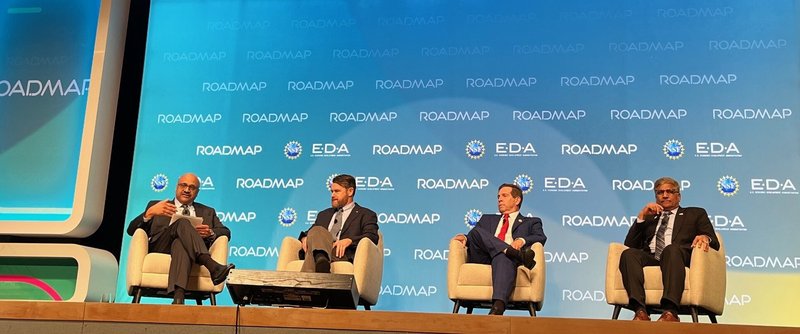Republican Congressional Leaders Affirm the Value of Place-based NSF and EDA Investments
Blog Post

Feb. 3, 2025
This article was produced as part of New America’s Future of Work and the Innovation Economy Initiative. Subscribe to our Future of Work Bulletin newsletter to stay current on our latest research, events, technical assistance, and storytelling.
The promise of technological innovation rose above partisanship at the first ROADMAP Summit, a convening of science- and technology-based economic development leaders and federal grantees organized by the U.S. National Science Foundation and the U.S. Economic Development Administration. For the first time, the convening united recipients of key place-based innovation investments—including NSF Regional Innovation Engines, EDA Tech Hubs, and Build Back Better grantees. At the December summit, leaders from both parties advocated for sustained investment in U.S. growth and global leadership.
The ROADMAP summit counted among its speakers two longtime Republican members of Congress, Senator Todd Young of Indiana and Representative Chuck Fleischmann of Tennessee, who represent the industrial heartland and have long supported the CHIPS & Science Act and the projects it funds. Joining NSF Director Sethuraman Panchanathan, both members of Congress expressed guarded optimism for the United States’ position as a leader in innovation across emerging technology fields emphasized in CHIPS, including artificial intelligence and biotechnology. National security and competition were key concerns for panelists and were seen as barriers to improving the United States’ standing domestically and abroad.
Young, who co-authored the CHIPS & Science Act, described innovation as a means to drive unprecedented advancements like curing cancer while protecting American national security. Young has already made clear his support for CHIPS investments, such as the U.S. Economic Development Administration’s Regional Technology and Innovation Hubs or “Tech Hubs” program. Indiana’s Heartland Bioworks Tech Hub is projected to bring $2.6 billion in new economic output over the next decade and create 9,000 jobs. A broad coalition of partners, including industry, universities, economic developers, and community colleges, supports the efforts.
Fleischmann, a champion of technological innovation in the House, expressed similar concerns about the competitiveness implications of delaying federal investments in research and development. A longtime appropriator who leads its energy and water subcommittee, he is co-chair of the House Advanced Nuclear Caucus and the Fusion Energy Caucus, which both seek to promote energy sources that counter the United States’s long-standing reliance on fossil fuels like coal and natural gas. His emphasis on the nuclear workforce stems from his district’s economic needs; his Tennessee district includes a nuclear power plant and a national laboratory host to atomic research and development activities. Fleischmann represented his Tennessee district when the Obama administration selected it as the Oak Ridge National Laboratory site. In this panel, he highlighted the lab’s site selection process as an example of bipartisan collaboration and a merit-based approach prioritizing regions with strong growth potential. He credited this approach, rather than partisanship, for delivering “tremendous” returns to his constituents and emphasized that similar bipartisan strategies could make CHIPS investments equally successful.
Sustaining Investments in Tech Hubs and Innovation Ecosystems
As the Trump administration and Congress consider ways to bend industrial policy to suit their constituents' priorities, Young and Fleischmann’s comments solicited continued focus on innovation investments.
While most U.S. states now claim a Tech Hub, Engine, or Build Back Better Regional Challenge award, the CHIPS & Science Act, which passed with bipartisan support, remains only partially appropriated–a challenge that remains as Speaker Mike Johnson leads his caucus in the new Congress, having previously argued for a repeal of the Act (though he later played down those comments). Examples of this incomplete appropriation include the 2024 budget underfunding the NSF by 42% and giving Tech Hubs just 5% of their authorized amount. Though an additional $210 million from the FY25 NDAA (an extra 2%) demonstrated progress, these programs deserve what the CHIPS & Science Act called for. As Panchanathan noted, “not even half of the potential in our nation is being taken advantage of.”
Leaders from industry, community colleges, and state and local leaders alike are calling on Congress to follow through on CHIPS Act investments and see hope and room for consensus and partnership. For his part, Fleischmann was hopeful that bipartisanship for scientific and technological innovation would continue. “It’s my prayer that this survives beyond just one administration to another…folks like Todd and I in Congress, we’re going to push that collaboration.”
Many competing priorities will influence decision-making on Capitol Hill this spring. Still, one thing is sure following the ROADMAP summit: the innovation community is hopeful that Republican lawmakers will align with their colleagues when finalizing appropriation funding to programs like NSF Engines and EDA Tech Hubs.